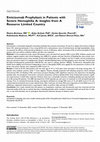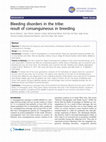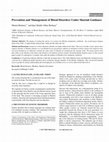Papers by Dr. Munira Borhany

Clinical and Applied Thrombosis/Hemostasis, Dec 31, 2023
Emicizumab is a humanized, bispecific monoclonal antibody that connects active factor IX and X to... more Emicizumab is a humanized, bispecific monoclonal antibody that connects active factor IX and X to replace the function of absent factor VIII, restoring hemostasis. It has a long half-life with a subcutaneous route of administration and high bioavailability. Here, we assessed the efficacy of Emicizumab prophylaxis in terms of efficiency, safety, and quality of life of severe hemophilia A (HA) patients with and without inhibitors before and after this treatment. Methods: In this prospective study, severe HA patients were recruited from January 2022 to June 2023. Inhibitor positive and inhibitor negative patients with annual bleeding rate (ABR) 8 or greater and past histories of bleeding like intra-cranial, intraabdominal, and pseudo-tumors were included. Emicizumab loading dose was 3 mg/kg in the first 4 weeks, and the maintenance dose was started at week 5 at 6 mg/kg/month. Patients' detailed bleeding history and demographics were recorded. The five-level EuroQol five-dimensional questionnaire (EQ-5D-5L) was used to evaluate patients' HRQoL. Furthermore, Hemophilia Joint Health Score (HJHS) and Functional Independence score in Hemophilia (FISH) were applied for the assessment of joints at different time points. Results were analyzed by SPSS version 21. Results: A total of 36 HA male patients with the mean age of 19.7 ± 14.42 years were recruited in the study; among them, 19 patients were inhibitor positive, while 17 were negative. Patients clinically presented with bleeding symptoms which included: hemarthrosis 95%, GI bleeding 13.8%, and bruises and gums bleeding 13.8%. Significant reduction was observed in the bleeding episodes after the therapeutic intervention, and joints assessment and Euro-Quality-of-life Visual Analog Scale showed a significant improvement in health after treatment. Similarly, there was a remarkable reduction in bleeding episodes and improved quality of life among HA patients. The ABR decreased from 53.6% episodes per year prior to treatment to 2.4% during Emicizumab therapy. Prior to initiating Emicizumab therapy, participants exhibited an average FISH score of 16 and HJHS score of 10, indicating moderate limitations due to joint-related issues. After treatment, the mean FISH score improved to 9 and HJHS score to 4 reflecting a substantial enhancement in participants' ability to perform daily activities (P < 0.057). Conclusion: Our results showed that HA patients on prophylactic treatment with Emicizumab were less restricted and had improved quality of life due to marked decrease in bleeding episodes which resulted in improved health and social lives. In addition, it was well tolerated, and no participant discontinued treatment because of adverse events.

Emicizumab is a humanized, bispecific monoclonal antibody that connects active factor IX and X to... more Emicizumab is a humanized, bispecific monoclonal antibody that connects active factor IX and X to replace the function of absent factor VIII, restoring hemostasis. It has a long half-life with a subcutaneous route of administration and high bioavailability. Here, we assessed the efficacy of Emicizumab prophylaxis in terms of efficiency, safety, and quality of life of severe hemophilia A (HA) patients with and without inhibitors before and after this treatment. Methods: In this prospective study, severe HA patients were recruited from January 2022 to June 2023. Inhibitor positive and inhibitor negative patients with annual bleeding rate (ABR) 8 or greater and past histories of bleeding like intra-cranial, intraabdominal, and pseudo-tumors were included. Emicizumab loading dose was 3 mg/kg in the first 4 weeks, and the maintenance dose was started at week 5 at 6 mg/kg/month. Patients' detailed bleeding history and demographics were recorded. The five-level EuroQol five-dimensional questionnaire (EQ-5D-5L) was used to evaluate patients' HRQoL. Furthermore, Hemophilia Joint Health Score (HJHS) and Functional Independence score in Hemophilia (FISH) were applied for the assessment of joints at different time points. Results were analyzed by SPSS version 21. Results: A total of 36 HA male patients with the mean age of 19.7 ± 14.42 years were recruited in the study; among them, 19 patients were inhibitor positive, while 17 were negative. Patients clinically presented with bleeding symptoms which included: hemarthrosis 95%, GI bleeding 13.8%, and bruises and gums bleeding 13.8%. Significant reduction was observed in the bleeding episodes after the therapeutic intervention, and joints assessment and Euro-Quality-of-life Visual Analog Scale showed a significant improvement in health after treatment. Similarly, there was a remarkable reduction in bleeding episodes and improved quality of life among HA patients. The ABR decreased from 53.6% episodes per year prior to treatment to 2.4% during Emicizumab therapy. Prior to initiating Emicizumab therapy, participants exhibited an average FISH score of 16 and HJHS score of 10, indicating moderate limitations due to joint-related issues. After treatment, the mean FISH score improved to 9 and HJHS score to 4 reflecting a substantial enhancement in participants' ability to perform daily activities (P < 0.057). Conclusion: Our results showed that HA patients on prophylactic treatment with Emicizumab were less restricted and had improved quality of life due to marked decrease in bleeding episodes which resulted in improved health and social lives. In addition, it was well tolerated, and no participant discontinued treatment because of adverse events.

Background and objective Allogeneic hematopoietic stem cell transplantation (alloHSCT) provides c... more Background and objective Allogeneic hematopoietic stem cell transplantation (alloHSCT) provides curative treatment for several hematological illnesses. In this study, we evaluated the impact of ABO compatibility and incompatibility on outcomes and complications related to hematopoietic stem cell transplantation (HSCT) performed for various hematological disorders at our center. Methodology This was a retrospective, single-center, cohort study in which patients were categorized according to the ABO match and mismatch status. The mismatch group was further subcategorized into major, minor, and bidirectional groups. Results A total of 117 patients underwent alloHSCT, out of which 82 (70.1%) were male and 35 (30%) were female. The median age of the patients was 9.5 years (range: 46 years). The most common indications for stem cell transplant were beta-thalassemia major (BTM; n=58, 49%) and aplastic anemia (AA; n=42, 35.8%). However, the outcomes in match and mismatch groups showed significant results for positive direct Coombs test (DCT), indicating the occurrence of hemolysis. Despite the increased need for blood transfusions, ABO blood group incompatibility (ABOi) had no negative impact on the clinical results. Conclusion Based on our findings, ABO incompatibility does not affect the outcomes in patients undergoing alloHSCT. Patient monitoring can aid in early detection and treatment, thereby minimizing the frequency of fatal events.
The Japanese Society of Hematology, Sep 11, 2019

β-thalassaemia, an autosomal recessive hemoglobinopathy, is one of the commonest genetically tran... more β-thalassaemia, an autosomal recessive hemoglobinopathy, is one of the commonest genetically transmitted disorders throughout the world. Collective measures including carrier identification, genetic counseling and prenatal diagnosis are required for preventing β-thalassemia. To achieve this objective, Identification of the spectrum of genetic mutations, especially for various ethnic backgrounds in Pakistan is necessary. Therefore, we designed a cross sectional prospective study to identify the frequency of various gene mutations in different ethnic groups of Pakistan. Over a 5-year period, DNA from 648 blood samples [including specimens of chorionic villus sampling (CVS)] were analyzed for the twelve most common β-thalassemia mutations found in the Pakistani population by a Multiplex amplification refractory mutation system (ARMS). The most common mutation identified was Intervening Sequence 1-5 (IVS 1-5 (G-C)); accounting for 40.89% mutated alleles, and was represented in all ethnic groups. 15.7 % of the βthalassemia alleles were found to have Frameshift 8-9 (Fr 8-9) as the second most common mutation Other common genetic defects responsible for β-thalassemia: IVS 1-1 (G-T) was found in 8.17%, Codon-30 (Cd-30 (G-C)) 8.02%, Codon-5(Cd-5 (-CT)) contributed 2.16% and Deletion 619 base pair (Del 619bp) affected 11.11% were found in Pakistan. This large study adds to the pre-existing data in Pakistan. Knowledge of the predominant mutation in a given ethnic group will not only help in developing a short panel of (population-specific) primers of mutations thereby providing a cost-effective method for prenatal diagnosis and also help the clinicians to counsel regarding blood transfusion regimen/ pregnancy termination.

Clinical and Applied Thrombosis-Hemostasis, Dec 15, 2010
This study was conducted on patients with a history of congenital bleeding disorders or with susp... more This study was conducted on patients with a history of congenital bleeding disorders or with suspected bleeding tendencies. Laboratory analysis revealed Von Willebrand disease (VWD) in 68 (21.3%) of 318 participants with male to female ratio of 0.8: 1 (31 to 37) and median age 17 years (range 2-45 years). Type 3 being the most frequent, 35 (51.4%) of 68, type 2, 20 (29.4%) of 68, and lastly type 1, 13 (19.1%) of 68. A total of 55.8% patients with VWD presented with mucocutaneous bleeding. Menorrhagia was the most common presentation of female patients. Von Willebrand disease (21.3%) was the second common bleeding disorder and the most common coagulation defect among females with menorrhagia. However, the frequency in the study was quite low when compared to the western world. Similarly, low frequency of VWD type 1 might be due to the fact that only symptomatic patients visited us. Further studies are needed as there is limited information on VWD in the developing countries. This will help in the development of expertise for the accurate diagnosis & proper management.

Orphanet Journal of Rare Diseases, Sep 7, 2010
Objective: To determine the frequency and clinical features of bleeding disorders in the tribe as... more Objective: To determine the frequency and clinical features of bleeding disorders in the tribe as a result of consanguineous marriages. Design: Cross Sectional Study Introduction: Countries in which consanguinity is a normal practice, these rare autosomal recessive disorders run in close families and tribes. Here we describe a family, living in village Ali Murad Chandio, District Badin, labeled as haemophilia. Patients & Methods: Our team visited the village & developed the pedigree of the whole extended family, up to seven generations. Performa was filled by incorporating patients, family history of bleeding, signs & symptoms, and bleeding from any site. From them 144 individuals were screened with CBC, bleeding time, platelet aggregation studies & RiCoF. While for PT, APTT, VWF assay and Factor VIII assay, samples were kept frozen at-70 degrees C until tested. Results: The family tree of the seven generations comprises of 533 individuals, 63 subjects died over a period of 20 years and 470 were alive. Out of all those 144 subjects were selected on the basis of the bleeding history. Among them 98(68.1%) were diagnosed to have a bleeding disorder; 44.9% patients were male and 55.1% patients were female. Median age of all the patients was 20.81, range (4 months-80 yrs). The results of bleeding have shown that majority had gum bleeding, epistaxis and menorrhagia. Most common bleeding disorder was Von Willebrand disease and Platelet functional disorders. Conclusion: Consanguineous marriages keep all the beneficial and adversely affecting recessive genes within the family; in homozygous states. These genes express themselves and result in life threatening diseases. Awareness, education & genetic counseling will be needed to prevent the spread of such common occurrence of these bleeding disorders in the community.

Cureus
Introduction: Prophylactic clotting factor infusion regimens to prevent bleeding and joint deform... more Introduction: Prophylactic clotting factor infusion regimens to prevent bleeding and joint deformity has become the standard of care in severe hemophilia A patients. Aim: To assess low-dose factor prophylaxis in our population as an alternative approach to managing severe hemophilia A. Methods: A prospective cohort study that included 68 hemophilia A patients divided into two groups, i.e., Prophylaxis and on-demand. The two groups were compared for annualized bleeding rate (ABR), hospitalization, units of factor VIII (FVIII) infused, or plasma products transfused, i.e., fresh frozen plasma (FFP) and cryoprecipitate (CP), and development of FVIII inhibitors. Results: Of the 68 patients recruited in this study, 25 (36.7%) were in the prophylaxis group, and 43(63.3%) were in the on-demand group. The on-demand group presented a higher median-IQR ABR [8(20-3) vs. 5(10-1.5), p-value 0.024], several hospitalizations (39.7% vs. 0, p-value 0.001), and inhibitor development (9.3% vs. 0, p-value 0.289) compared to the prophylaxis group. The prophylaxis approach demonstrated a significant negative correlation of ABR with FVIII prophylaxis (r=-0484, p=value=0.014). Moreover, no hospitalizations or inhibitor development was observed in the prophylaxis group. The estimated annual consumption of FVIII was 328 IU/kg/year in the on-demand group and 1662.6 IU/kg/year in the prophylaxis group. However, a highly significant difference in plasma product utilization was observed between the two groups, i.e., p-value <0.001 and 0.038 for FFP and CP, respectively. Conclusion: Low-dose factor prophylaxis resulted in improved outcomes compared to on-demand treatment in terms of ABR, joint bleeding, hospitalization, and the development of inhibitors. This treatment approach should be adopted as an economically feasible alternative to high-dose Prophylaxis in resource-constrained countries.

Translational Medicine Communications
Background Prophylactic platelet transfusion is given to patients when the platelet count is less... more Background Prophylactic platelet transfusion is given to patients when the platelet count is less than ten thousand to prevent clinically significant bleeding till platelet engraftment is documented. Despite a very low platelet count, if platelet engraftment is confidently predicted, then platelet transfusion can be avoided in an otherwise stable patient. Objective To determine the role of post-transplant day + 14 immature reticulocyte fraction (IRF) and immature platelet fraction (IPF) as surrogate markers for early prediction of platelet engraftment in pediatric hematopoietic stem cell transplant patients. Material and methods This prospective study was done at the National Institute of Blood Diseases and Bone Marrow Transplantation between January 2017 and December 2020. A total of 56 and 31 patients were enrolled in the deviation and validation cohorts respectively. IPF and IRF were tested on a Sysmex XN-1000 hematology analyzer on days + 14 and + 21 of the bone marrow transplan...

Cureus
Objectives: This study aimed to determine the impact of prognostic markers on the outcomes of Hod... more Objectives: This study aimed to determine the impact of prognostic markers on the outcomes of Hodgkin lymphoma. Methods: It is a cross-sectional, single-center study. A total of 60 patients diagnosed with Hodgkin lymphoma were recruited for the study over five years between 2016 to 2020. The study setting was the National Institute of Blood and Bone Marrow Transplant in Pakistan. The Statistical Package for Social Sciences (SPSS) version 23 (IBM Corp., Armonk, NY, USA) was used for statistical analysis. Results: In the study population, 63.3% of the patients were male (38/60), and 36.7% were female (22/60). Hodgkin lymphoma was divided into four stages: stage I (18.3%), stage II (18.3%), stage III (46.7%), and stage IV (16.7%). Patients in stage III had a higher value of hemoglobin (Hb) than in other stages of the disease. The erythrocyte sedimentation rate was high in 56.7% of stage III patients than in patients of the other stages. The lactate dehydrogenase (LDH) levels were not under the normal range in 51.6% of patients. Only 20% of patients in stage III had LDH values within the normal range, whereas 26.6% did not. Conclusion: There was a significant impact of prognostic factors on the survival of patients with Hodgkin lymphoma.

Cureus
Aims and objectives: Our goal is to disseminate data on the distribution pattern of Rh antigen, i... more Aims and objectives: Our goal is to disseminate data on the distribution pattern of Rh antigen, its phenotypes, and the likely genotypes of these genetic variants in the Pakistani population. Methodology: This study was a cross-sectional research project. Patients' demographic statistics, such as age and gender, were gathered from their medical information. Blood group, disease, RhD, and other antigen frequency, phenotype, and probable genotype were considered variables. All blood samples were phenotyped for Rhesus antigens (D, C, c, E, and e), and the test was carried out using the tubing technique. Results: According to gender distribution, most of the patients were males, with 131 frequencies (57.7%), while females had 42.35%. The most common phenotype was DCCee, with its probable genotype DCe/DCe (R1 R1) (34%), followed by DCcee, with probable genotype DCe/ce (R1 r) (29.1%); the least common phenotype was ddCcee, with its probable genotype Ce/ce (r ' r) (0.4%). Conclusion: It is concluded that the DCCee phenotype was the most common with its probable genotype DCe/DCe, while the least common phenotype was ddCcee with its probable genotype Ce/ce.

Cureus
Aim and objective This study aimed to examine the relationship between serum ferritin levels and ... more Aim and objective This study aimed to examine the relationship between serum ferritin levels and the degree of hepatic fibrosis as detected on Fibroscan in thalassemia patients. Materials and methods This was a single-center and cross-sectional study conducted from April 2021 to December 2022. The sample population comprised 55 beta-thalassemia patients receiving treatment at the National Institute of Blood Diseases and Bone Marrow Transplantation, Karachi, Pakistan. The data was compiled through a series of patient interviews, an examination of medical records and was analyzed to obtain the results. Descriptive statistics were used for several variables, including diagnosis, Fibroscan score, blood group, comorbidity, visceromegaly, consanguinity, serum glutamate pyruvate transaminase (SGPT), viral markers, and C reactive protein (CRP). The correlation analysis was done using Spearman&#39;s correlation test. Results There were 55 participants in the study, 40 of whom were male and 15 of whom were female. The mean age of the patients was eight years, while the average age at diagnosis was nine months with a transfusion frequency of every 20 days. Spearman&#39;s rho (r = 0.287), and the significant value of (p = 0.033) confirmed a statistically significant positive correlation between serum ferritin levels and hepatic fibrosis. On Fibroscan, 74.5% of patients had F0-F1 stage fibrosis followed by 14.5% of the patients having F2 stage fibrosis. HCV seropositivity was the most prevalent comorbidity among the patients. 80% of patients had serum ferritin levels greater than 1000 ug/mL. Hepatosplenomegaly was present in 43.6% of the patients. 78.2% of patients were born out of consanguineous marriages. Conclusion In conclusion, this study found a statistically significant positive correlation between serum ferritin levels and hepatic fibrosis in beta-thalassemia patients. The study emphasizes the significance of monitoring serum ferritin levels in thalassemia patients to prevent hepatic fibrosis.

Immune thrombocytopenic purpura (ITP) is an autoimmune disorder characterized by low platelet cou... more Immune thrombocytopenic purpura (ITP) is an autoimmune disorder characterized by low platelet count and various contributing factor. The imbalance in T cells may also cause ITP. Therefore, the present study was planned to assess the role of T-cells in pathogenesis of ITP and also to evaluate any possible link of Th:Tc imbalance to disease severity. Methods: The present study was conducted with 111 patients of ITP and similar number of controls as case control study with 1:1 ratio of from January 2017 to July 2019. The patients were grouped according to the guideline of ASH as newly diagnosed/persistent ITP(ND-ITP/P-ITP) and chronic/refractory ITP(C-ITP/R-ITP).The blood samples were obtained, and CBC parameters were observed using advanced hematology analyzer XN-1000.The T cells subset analysis was evaluated by BD FACS Calibur flow cytometer. The Fisher exact test was done to evaluated the difference among the groups with (p=<0.05) by using SPSS version 19. Results: Significantly reduced levels of hemoglobin, platelet counts with elevated IPF were observed in ND-ITP/P-ITP and C-ITP/R-ITP patients (p=<0.001).The significantly low Th:Tc ratio (p=<0.001) predicts imbalance of T cells in ND-ITP/P-ITP (0.86±0.47) as compared to control group (1.73±0.46).The mean of 0.84±0.34 Th:Tc ratio was observed in C-ITP/R-ITP children with ≤16 years. An insignificant difference (p= 0.89) was linked between children with non-severe chronic (0.84±0.42), severe chronic (0.82±0.49) and refractory ITP (0.85±0.51). Conclusion: In ITP patients' low levels of Th:Tc ratio was observed suggesting dysregulation of immune system. The chronicity of the disease may be linked to elevated production of Tc in children (≤16 years) with C-ITP/R-ITP.

Aim and objective This study aimed to examine the relationship between serum ferritin levels and ... more Aim and objective This study aimed to examine the relationship between serum ferritin levels and the degree of hepatic fibrosis as detected on Fibroscan in thalassemia patients. Materials and methods This was a single-center and cross-sectional study conducted from April 2021 to December 2022. The sample population comprised 55 beta-thalassemia patients receiving treatment at the National Institute of Blood Diseases and Bone Marrow Transplantation, Karachi, Pakistan. The data was compiled through a series of patient interviews, an examination of medical records and was analyzed to obtain the results. Descriptive statistics were used for several variables, including diagnosis, Fibroscan score, blood group, comorbidity, visceromegaly, consanguinity, serum glutamate pyruvate transaminase (SGPT), viral markers, and C reactive protein (CRP). The correlation analysis was done using Spearman's correlation test. Results There were 55 participants in the study, 40 of whom were male and 15 of whom were female. The mean age of the patients was eight years, while the average age at diagnosis was nine months with a transfusion frequency of every 20 days. Spearman's rho (r = 0.287), and the significant value of (p = 0.033) confirmed a statistically significant positive correlation between serum ferritin levels and hepatic fibrosis. On Fibroscan, 74.5% of patients had F0-F1 stage fibrosis followed by 14.5% of the patients having F2 stage fibrosis. HCV seropositivity was the most prevalent comorbidity among the patients. 80% of patients had serum ferritin levels greater than 1000 ug/mL. Hepatosplenomegaly was present in 43.6% of the patients. 78.2% of patients were born out of consanguineous marriages. Conclusion In conclusion, this study found a statistically significant positive correlation between serum ferritin levels and hepatic fibrosis in beta-thalassemia patients. The study emphasizes the significance of monitoring serum ferritin levels in thalassemia patients to prevent hepatic fibrosis.

Aim and objective This study aimed to examine the relationship between serum ferritin levels and ... more Aim and objective This study aimed to examine the relationship between serum ferritin levels and the degree of hepatic fibrosis as detected on Fibroscan in thalassemia patients. Materials and methods This was a single-center and cross-sectional study conducted from April 2021 to December 2022. The sample population comprised 55 beta-thalassemia patients receiving treatment at the National Institute of Blood Diseases and Bone Marrow Transplantation, Karachi, Pakistan. The data was compiled through a series of patient interviews, an examination of medical records and was analyzed to obtain the results. Descriptive statistics were used for several variables, including diagnosis, Fibroscan score, blood group, comorbidity, visceromegaly, consanguinity, serum glutamate pyruvate transaminase (SGPT), viral markers, and C reactive protein (CRP). The correlation analysis was done using Spearman's correlation test. Results There were 55 participants in the study, 40 of whom were male and 15 of whom were female. The mean age of the patients was eight years, while the average age at diagnosis was nine months with a transfusion frequency of every 20 days. Spearman's rho (r = 0.287), and the significant value of (p = 0.033) confirmed a statistically significant positive correlation between serum ferritin levels and hepatic fibrosis. On Fibroscan, 74.5% of patients had F0-F1 stage fibrosis followed by 14.5% of the patients having F2 stage fibrosis. HCV seropositivity was the most prevalent comorbidity among the patients. 80% of patients had serum ferritin levels greater than 1000 ug/mL. Hepatosplenomegaly was present in 43.6% of the patients. 78.2% of patients were born out of consanguineous marriages. Conclusion In conclusion, this study found a statistically significant positive correlation between serum ferritin levels and hepatic fibrosis in beta-thalassemia patients. The study emphasizes the significance of monitoring serum ferritin levels in thalassemia patients to prevent hepatic fibrosis.

Cureus, 2023
Introduction: Prophylactic clotting factor infusion regimens to prevent bleeding and joint deform... more Introduction: Prophylactic clotting factor infusion regimens to prevent bleeding and joint deformity has become the standard of care in severe hemophilia A patients. Aim: To assess low-dose factor prophylaxis in our population as an alternative approach to managing severe hemophilia A. Methods: A prospective cohort study that included 68 hemophilia A patients divided into two groups, i.e., Prophylaxis and on-demand. The two groups were compared for annualized bleeding rate (ABR), hospitalization, units of factor VIII (FVIII) infused, or plasma products transfused, i.e., fresh frozen plasma (FFP) and cryoprecipitate (CP), and development of FVIII inhibitors. Results: Of the 68 patients recruited in this study, 25 (36.7%) were in the prophylaxis group, and 43(63.3%) were in the on-demand group. The on-demand group presented a higher median-IQR ABR [8(20-3) vs. 5(10-1.5), p-value 0.024], several hospitalizations (39.7% vs. 0, p-value 0.001), and inhibitor development (9.3% vs. 0, p-value 0.289) compared to the prophylaxis group. The prophylaxis approach demonstrated a significant negative correlation of ABR with FVIII prophylaxis (r=-0484, p=value=0.014). Moreover, no hospitalizations or inhibitor development was observed in the prophylaxis group. The estimated annual consumption of FVIII was 328 IU/kg/year in the on-demand group and 1662.6 IU/kg/year in the prophylaxis group. However, a highly significant difference in plasma product utilization was observed between the two groups, i.e., p-value <0.001 and 0.038 for FFP and CP, respectively. Conclusion: Low-dose factor prophylaxis resulted in improved outcomes compared to on-demand treatment in terms of ABR, joint bleeding, hospitalization, and the development of inhibitors. This treatment approach should be adopted as an economically feasible alternative to high-dose Prophylaxis in resource-constrained countries.

Haemophilia, 2022
INTRODUCTION The B-Natural study is a multicentre, multinational, observational study of haemophi... more INTRODUCTION The B-Natural study is a multicentre, multinational, observational study of haemophilia B (HB) designed to increase understanding of clinical manifestations, treatment and quality of life (QoL). AIM To characterise and compare QoL in HB across disease severity groups and individuals with inhibitors to identify gaps in treatment. METHODS A total of 224 individuals from 107 families were enrolled from a total of 24 centres in North America (n = 16), Europe (n = 7) and Asia (n = 1). Of these, 68 (30.4%) subjects had severe (<1 IU/dL), median age 15.6 years, 114 (50.9%) moderate (1-5 IU/dL), age 13.3 years, and 42 (18.8%) mild (>5-< 40 IU/dL), age 12.1 years, disease. Twenty-nine participants had inhibitors or a history of inhibitors. Three versions of the EQ-5D instrument were used as a measure of QoL: proxy (ages 4-7), youth (ages 8-15) and self (age 16+). Each instrument included a visual analogue scale ranging from 100 (best health) to 0 (worst health) to assess current day's health (EQ VAS). Range-of-motion (ROM) for elbows, knees and ankles was assessed using a four-point scale, from which a composite score was calculated. RESULTS In all severity groups, a proportion of subjects showed less than optimal QoL. The majority of the mild and moderate severe participants reported a normal EQ-5D health profile (79% and 72%, respectively), whereas about half (47%) of the severe participants and only 13% of the inhibitor participants reported this profile. CONCLUSION The B-Natural study reveals impacted QoL in all disease severities of HB including those with inhibitors. Unmet needs remain and include nonsevere HB.

National Journal of Health Sciences, 2017
Objective: The purpose of writing this article is to convince the Muslim communities worldwide-th... more Objective: The purpose of writing this article is to convince the Muslim communities worldwide-the second largest religious entity of the world-to adopt modern medical steps, which provide safety and care. Methods and Discussion: Irrespective of their education, Muslims are highly influenced by Islam. They never consider science equal to their religion; therefore, in Muslim countries it is very difficult for any government, authority or institution to enforce norms in the respective medical sector through acts or ordinances. Instead, the canon source of Shariah can communicate this message easily. The masses practice their daily affairs as per Shariah as they believe that Shariah is the fountain of divine wisdom. Providing Muslim religious sources in this research paper is purely to communicate a scientific study under the guidance of Shariah to the community worldwide. Conclusion: It is hoped that numerous Muslims would take advantage from it. The Ulama [Muslim clergy] and Madrasahs [Seminaries] have a pivotal role in influencing health education and its promotion amongst members of the Muslim community. They can provide potential access to people for raising, understanding and encouraging the use of health services as well as ethnic blood donor drives.
Journal of the College of Physicians …, 2008
Objective: To determine the frequency of thrombotic complications and to identify factors associa... more Objective: To determine the frequency of thrombotic complications and to identify factors associated with arteriovenous thrombosis in patients of chronic renal failure receiving renal replacement therapy.











Uploads
Papers by Dr. Munira Borhany